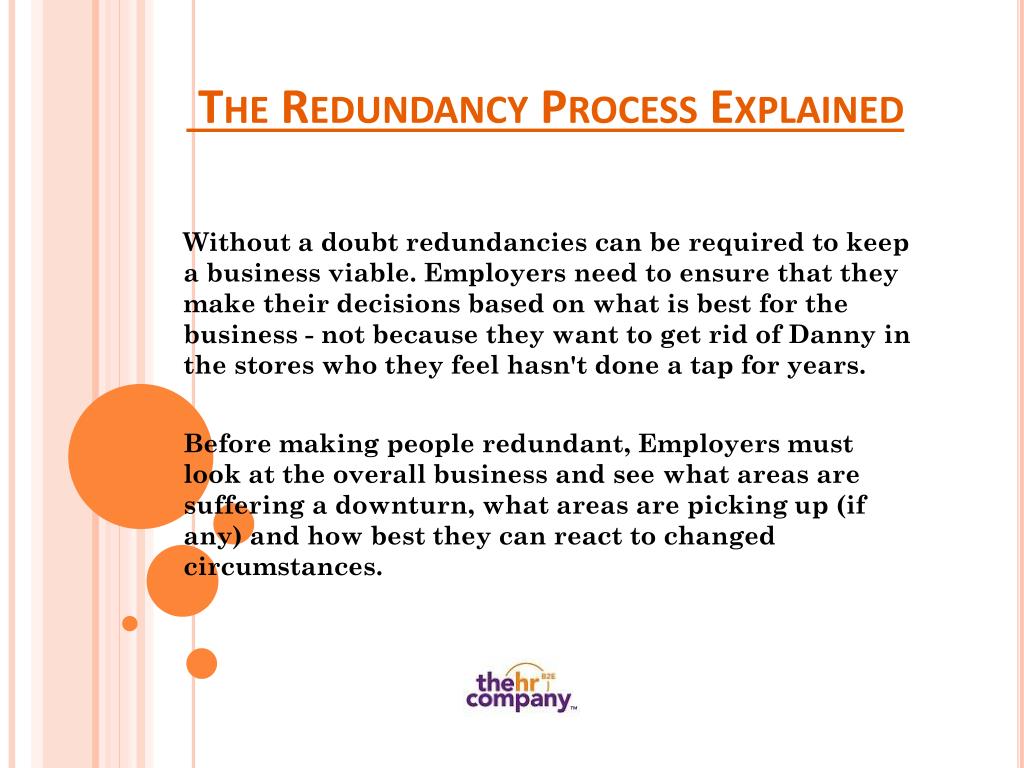Your Rights to Redundancy If Company Goes Bust: UK Employee Protections
Your Rights to Redundancy If Company Goes Bust: UK Employee Protections
Blog Article
Exploring the Interplay Between Business Redundancy and Business Flexibility for Future Development
In the dynamic landscape of today's service globe, the detailed relationship in between business redundancy and organizational versatility arises as a vital aspect for continual development and success. Companies commonly encounter the challenge of striking a delicate equilibrium between preserving a level of redundancy to minimize dangers and fostering adaptability to react quickly to the ever-evolving market needs.
Value of Company Redundancy
Company redundancy is a vital component that enhances organizational durability and reduces operational threats. By incorporating redundancy measures within the organizational structure, business can much better withstand unpredicted disturbances and variations in business setting. Redundancy acts as a tactical buffer, permitting business to adapt and respond efficiently to unexpected difficulties without endangering important operations.
One secret element of the significance of company redundancy is its function in guaranteeing connection during times of dilemma. When confronted with unexpected modifications or emergency situations, redundant systems, sources, or workers can tip in to preserve important features and avoid widespread disruptions. This connection not only safeguards the business's online reputation and consumer trust fund however additionally lessens economic losses and operational downtime.

Strategies for Organizational Versatility

Creating adaptable business structures that permit for quick changes to market characteristics and client needs is essential for remaining competitive in a quickly advancing setting. By proactively identifying potential disturbances and chances, companies can proactively adjust and prosper in an ever-changing company landscape.
Balancing Redundancy and Versatility
Attaining an unified stability between operational redundancy and organizational adaptability is critical in navigating the intricacies of a dynamic business atmosphere. Redundancy within a firm supplies a safety and security internet, making certain continuity and stability in operations. However, an unwanted of redundancy can bring about inefficiencies and impede adaptability to changing market conditions. On the various other hand, business versatility enables firms to respond quickly to exterior disturbances and confiscate brand-new chances. Striking the right equilibrium between redundancy and adaptability is a fragile procedure that requires a deep understanding of the company's objectives, market dynamics, and danger resistance.
To attain this equilibrium, companies need to perform normal analyses of their operations to recognize locations where redundancy is needed for risk mitigation and where flexibility can drive innovation and development. Carrying out versatile frameworks, fostering a society of continual learning and improvement, and urging open communication throughout all degrees of the company are crucial approaches to harmonize redundancy and flexibility effectively. By lining up these 2 essential aspects, companies can position themselves for lasting development and success in an ever-changing service landscape.
Case Studies on Adaptation Success
In analyzing instances of effective business adjustment, it comes to be obvious that the interplay between functional redundancy and flexibility is a defining variable in forming durable companies. One engaging situation research study is that of Netflix. Initially a DVD rental solution, Netflix demonstrated remarkable adaptability by transitioning into a streaming system when digitalization interfered with the industry. By strategically purchasing modern technology and web content creation, Netflix not just grew however survived in a rapidly progressing market. One more standout example is Amazon. Beginning as an on the click here for more info internet bookstore, Amazon constantly adjusted its business version, expanding right into varied sectors such as cloud computing and artificial intelligence. This adaptability enabled Amazon to stay in advance of competitors and fulfill transforming consumer needs. Last but not least, Adobe provides a notable picture of effective adaptation. The firm changed from marketing software program licenses to a subscription-based version, ensuring recurring revenue streams and improved customer engagement. These case studies highlight the relevance of operational redundancy coupled with business flexibility in promoting long-term growth and competitiveness.
Building Resilience for Future Growth
Structure strength for future development needs a critical alignment of operational procedures with market dynamics and emerging patterns. Business need to adapt to changing environments by fostering a culture of adaptability, technology, and constant improvement. Durability involves not just recuperating from setbacks but likewise proactively preparing for future obstacles. One vital aspect of building resilience is buying robust danger monitoring strategies to alleviate possible disturbances. This includes situation planning, branching out supply chains, and creating backup prepare for different contingencies (who pays redundancy money).
In addition, cultivating solid relationships with stakeholders, such as clients, staff members, distributors, and the neighborhood, is essential for maintaining and weathering unpredictabilities depend on and support throughout rough times. Effective interaction and transparency play an important function in structure resilience, as they aid facilitate and straighten expectations collaboration in browsing unpredictabilities.
Furthermore, companies require to focus on learning and development efforts to upskill staff members and furnish them with the essential tools to adjust to changing circumstances. By purchasing their workforce, business can improve their adaptability and dexterity, inevitably strengthening click for info their strength for sustainable future growth.
Conclusion

In the vibrant landscape of today's service world, the elaborate connection between company redundancy and organizational versatility emerges as an important aspect for sustained growth and success. Business typically deal with the challenge of striking a fragile balance between keeping a degree of redundancy to reduce risks and fostering versatility to respond promptly click resources to the ever-evolving market demands.To achieve this balance, firms require to carry out regular assessments of their operations to determine areas where redundancy is essential for threat mitigation and where flexibility can drive innovation and development.In final thought, the interplay between business redundancy and business flexibility is important for future growth. Building durability through a mix of redundancy and versatility will ensure that companies are prepared for the challenges of the future.
Report this page